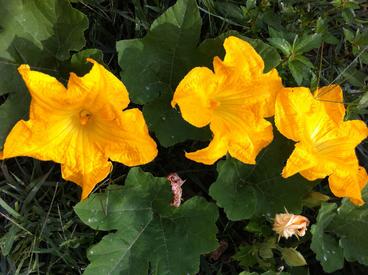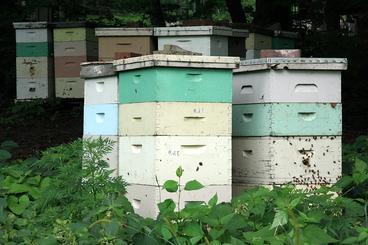Marla Spivak
Department of Entomology, University of Minnesota
Introduction
Vine crops, such as melons, cucumbers, squash, and pumpkins, require insect pollination to set fruit. Insects transfer pollen from the male flowers to female flowers through cross-pollination. Multiple pollinator visits increase the size of the fruit, the number of seeds, and the consistency in the shape of the fruit.
Honey Bees as Pollinators
Although many insects are capable of cross-pollination, honey bees are the most effective at accomplishing this task. Bees must visit flowers to obtain significant quantities of pollen to sustain the nutritional needs of the colony. Pollen is the sole source of protein for the bees. Bees' bodies are covered with fine hairs that catch and hold pollen, and they are endowed with specialized pollen collecting structures on their legs. When a bee collects pollen, she only visits one species of plant on any given foraging trip which ensures effective cross pollination. Bees communicate where food sources are located to help recruit a large number of foragers in a short time. Finally, large populations of honey bees can be maintained and moved to desired locations as pollination requirements change.
Our dependence on honey bee pollination has increased because the number of native bees and other pollinating insects has been reduced due to the use of pesticides and the destruction of nesting sites by modern agricultural technology. In the last decade, the number of honey bee colonies has diminished due to the introduction of two, highly destructive parasitic mites specific to honey bees. Many home gardeners and growers of large commercial crops have noticed the lack of honey bees and have taken an interest in renting or purchasing bee hives to increase pollination.
Characteristics of Vine Crops

Individual flowers on melons, cucumbers, squash and pumpkins are open for one day, usually in early morning. It is critical that sufficient pollinators be available when the flowers are open. Honey bees are attracted to the flowers for both nectar and pollen. Nectar, a sugary secretion of many plants, is the bee colony's source of carbohydrates. The bees convert the nectar into honey and store it within the nest. Individual flowers may have large quantities of nectar, but the number of open flowers any one day is low, so the amount of nectar collected does not result in a surplus of honey for the colony.
The flowers on vine crops need more than one bee visit per flower to set fruit. Each seed needs one pollen grain for fertilization. If insufficient pollen is carried to the female flower, the fruit will abort. The number of fertilized seeds is correlated with the final size of the melon, cucumber, squash, or pumpkin. For melons, the flowers near the base of plant produce the "crown set" which is sweeter fruit. With heavy bee activity, there is
Pollination Requirements

In a home garden, one honey bee colony located within 1/2 mile of the garden should provide enough pollination. However, some gardeners may be interested in keeping a hive of bees in their own yard for pollination of their vine crops, fruit trees, berries, and other fruits and vegetables that need to set seed. Colonies in a back yard or small farm will produce surplus honey from surrounding fields containing clover and alfalfa which can be harvested for personal use. A two-day short course is offered every March at the University of Minnesota for anyone interested in learning how to keep bees in northern climates. Contact Dr. Marla Spivak at the address below.
For a large commercial crop, 1-2 colonies per acre are needed to ensure adequate pollination. The grower may want to rent bee colonies from a commercial beekeeper for this purpose. Bee colonies should be placed in a melon or squash or pumpkin field before the first bloom because the first fruit set is the highest quality. Bee colonies can be moved into a cucumber field when the first 10% of the flowers are in bloom. Vine crops alone do not produce supplies honey for the beekeeper to harvest. If the colonies are left in the field for two to four weeks, the colonies will be lighter when they are removed than when they were delivered unless they are provided with supplemental feedings of sugar syrup.
It is important that the grower and beekeeper draw up a pollination agreement before the bees are brought into the field. The agreement will specify the rental fee and payment arrangements, where the colonies will be placed in the field, and when the bees should be delivered and removed. When determining the fee, the beekeeper will consider access: Can the bees be unloaded with a forklift? Can they be placed in a row along the edge of the field? Colonies should be placed within 100 yards of the field, and if possible, at 500 ft intervals. The beekeeper must agree to provide populous colonies, and to demonstrate the strength of the colonies as selected by the grower. Finally, it is very important that the grower not use pesticides on the crop when the flowers are blooming.
References
Furgala, B., M. Spivak, G. Reuter. 1993. Beekeeping in Northern Climates: Short Course Manual. 55pp. Distribution Number: EP-6684-S, MI-6683-S.
Spivak, M., and G. S. Reuter. 1996. Video: Honey Bee Management in Northern Regions. Minnesota and Wisconsin Extension Services. To be released in June, 1996.